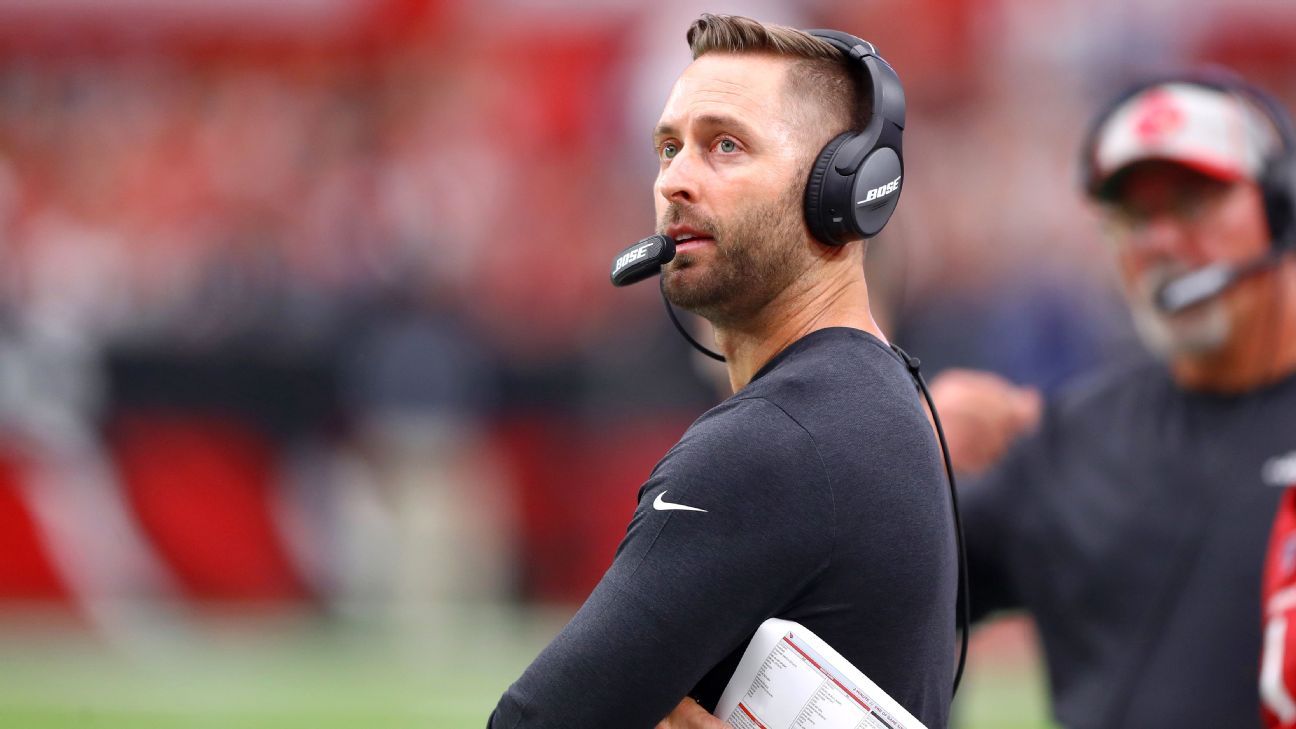TEMPE, Ariz. — One month into his NFL career, Arizona Cardinals coach Kliff Kingsbury has noticed one major difference between coaching in college and the NFL.
And it has forced Kingsbury to adapt. His offenses averaged 81.9 offensive plays per game in six seasons at Texas Tech, but in four games with the Cardinals, they are averaging just 67.
“I think the biggest takeaway is there’s no kind of throwaway plays in the NFL,” Kingsbury said. “In college, you may have 85, 90 snaps. There’s a handful that are kind of throwaways and you look back at them and [say], ‘Hey, that’s all right that there were five plays that maybe we didn’t have the best call on and it didn’t work out.’
“But, here, you better make every call count because there’s not as many plays and everybody is executing on a very, very high level.”
Against the Carolina Panthers in Week 3, the Cardinals had the ball one time in the first quarter — that happened just once in six seasons at Texas Tech — and just four times in the first half. That never happened at Texas Tech.
“There’s definitely a difference,” Kingsbury said.
Kingsbury is adjusting but also staying true to his roots as playcaller. He’s calling a lot of 10 personnel — four wide receivers with one running back — a rare formation in the NFL but one he used plenty at Texas Tech.
In four games, the Cardinals have run 10 personnel on 161 snaps out of 268 total offensive snaps. That’s 60% of time, a rate that’s slightly higher than the 56.3% clip Kingsbury used in six seasons in Lubbock.
Compared to the rest of the NFL, however, it’s unheard of.
The Los Angeles Rams rank second in 10 personnel plays with 23 — 138 plays behind the Cardinals. Eleven teams haven’t run it at all this season, including the Cincinnati Bengals who the Cardinals face this Sunday (1 p.m. ET, Fox).
“You certainly got a lot more speed out there with four guys that you’ve got to make sure you’re aware of downfield,” Bengals coach Zac Taylor said. “They have a really talented running back and really athletic quarterback, so the threat of the run is still very much real because of the things that they can do out of those run sets. They like to motion those guys and put you in some tough spots. It’s certainly a challenge.”
Detroit Lions coach Matt Patricia, who had to defend Kingsbury’s 10 personnel packages 56 times during a Week 1 tie, feels the one running back, no tight end, four receiver sets are “more common now-a-days,” which is saying something considering how little other teams run it.
“It’s not many teams around the league that are doing it, going into the sets that we’re in, so it kind of gets teams out of their comfort zone,” Cardinals receiver Larry Fitzgerald said. “They got to play guys probably that haven’t been playing throughout the course of the year so it’s asking a lot and then at the tempo that we’re going at, it puts a lot of stress on the communication.
“We see teams not getting lined up, not getting the right personnel, not getting the right calls.”
So how do you defend the 10? Personnel is key, but it’s “definitely a problem,” according to New England Patriots coach Bill Belichick.
“If you have four defensive backs, you’re kind of a guy short,” Belichick said. “If you have five defensive backs, you can matchup to them but then you have no deep help in kind of blitz-zero coverage. If you have six defensive backs, you can kind of play whatever you want.”
And that’s the rub. How many teams are built to use four, five or six defensive backs? Not many, Cardinals defensive coordinator Vance Joseph said.
“You’re lucky to have two corners,” Joseph said. “If you have four, you’re very lucky. Most teams don’t have four. You can’t pay four good players, I guess, you should say at corner. It’s a valuable spot in the league and you have to draft them high, and you have to find them and groom them, obviously.
“But it’s impossible to have four ‘ones’ or ‘twos’ on your team as far as corners.”
Early in the season, Kingsbury said he called so much 10 personnel because Arizona was trailing and needed to throw the ball to get back in the game. Based on his history at Texas Tech, it’s unlikely he’ll sway far from those sets, though, partly because it creates mismatches across the field.
It also “clears up some looks” for rookie quarterback Kyler Murray.
Cardinals wide receiver Damiere Byrd said the mismatches are created rather easily: If an extra defensive back is used, the run game becomes more effective but if the defense keeps a linebacker on the field, then there are mismatches inside in the passing game.
Arizona has already seen its share of mismatches, especially with Fitzgerald and Christian Kirk running routes down the middle of the field where they’re defended by linebackers and safeties, Byrd said.
Skeptics might say the Cardinals are not off to a resounding offensive success. They rank 23rd in yards per game and 25th in scoring. But it’s important to remember they finished dead last in both categories last season.
Byrd said playing four and five wide sets is a “receiver’s dream.” But it’s also a work in progress. “It’s going to be trial and error,” he said.
